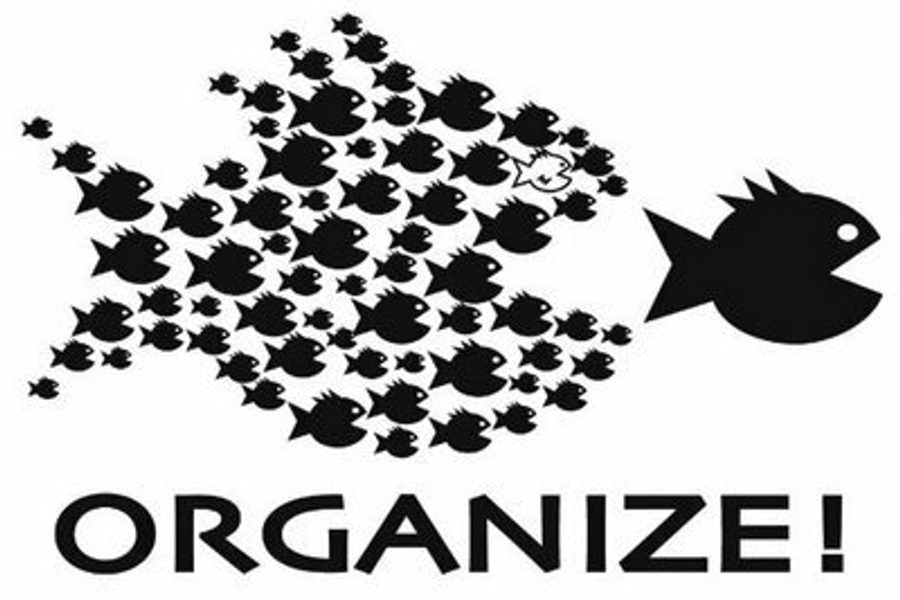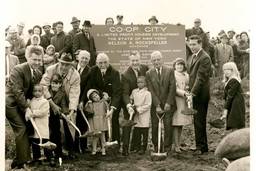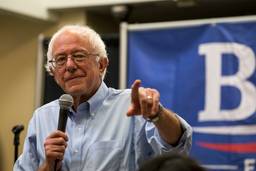
A shorter version of this piece originally ran in Labor Notes.
“Mate, what do you think of the ‘Organizing Model’? That’s an American thing, isn’t it?”
I was sorting my notes during a short break at an IWW training in London. The question took me off guard.
“Umm… which organizing model?” I replied quizzically. There were multiple organizing models, right? Alinsky, ACORN, SEIU, member-to-member, staff-driven, Solidarity… and so on. I chalked it up to U.S.-UK cultural misunderstanding.
But a few weeks later, at another training in Cologne, Germany, someone asked – “Das ‘Organizing Model’ ist in den USA sehr beliebt, oder?”
Here it was again. In German. I decided to do some digging.
As I got deeper in Google searches, academic journals, and labor movement archives, I realized that I was slowly unearthing a concept so foundational to the contemporary labor movement that most activists of my generation hardly realize it is there. It turns out the United States doesn’t only export Backstreet Boys and Big Macs, we also export the trends of our unions. Over the last 15 years, as American management practices cast a pall over the global economy, unions in the UK, the Netherlands, Germany, Australia, and beyond have looked to the United States for survival strategies, and came back with ‘the Organizing Model.’
What is the ‘Organizing Model’?
In the first half of the 1980s, the U.S. labor movement lost a fifth of its membership to union-busting, plant closings, outsourcing, deregulation, automation, two recessions, and the growth of the non-union service sector. Union leaders began looking for ways to stop the bleeding.
The AFL-CIO unveiled its answer in 1988: “internal organizing.” The goal was to revive a social movement feeling in unions by bringing the mobilizing techniques used in external organizing drives into existing bargaining units. Activists, who had seen U.S. unions ossify into bureaucratic dinosaurs, welcomed the focus on rank-and-file participation. The manual, “Numbers that Count,” rapidly became one of the AFL-CIO’s most requested publications.
From the Organizing Model to External Organizing
At the same time, AFL-CIO leaders began to push for affiliated unions to organize the unorganized. In 1989 they established an Organizing Institute to train members and staff in the craft.
However, the connection between these two forms of “organizing” — building more participatory locals and recruiting new members — remained murky, and commitment to organizing amongst unions was uneven. Some union officers even thought that fighting harder against employers would only give bosses more reasons to resist unions.
Union density hit a new low of 14.9 percent in 1995, convincing many that the measures taken by the AFL-CIO were not just too late, but too little. Frustration boiled over, propelling the “New Voice” slate to victory in the AFL-CIO’s executive board elections with a pledge to push for organizing. The new officers increased the budget of the Organizing Institute and released a blueprint entitled “Organizing for Change, Changing to Organize.” They called on AFL-CIO affiliates to put some muscle on the Organizing Model by throwing more professional staff, more money (30 percent of their budgets), more planning, and more member activity into organizing new shops.
New voice, new contradictions
If the U.S. labor movement briefly seemed united behind organizing, it didn’t last long. Many officers thought 30 percent was too much money to dedicate to it. Some saw the new agenda as the AFL-CIO meddling in their internal politics. The shift of resources away from “servicing” members created tensions among officers, staffs, and members — between those energized by the prospect of expanding labor’s ranks and those who wanted to focus on enforcing contracts in existing locals.
However, even amongst those who endorsed Change to Organize, a split began to develop. Some unionists favored a ‘movement building’ approach to external organizing, where rank-and-file members volunteered or were paid ‘lost time’ to work on external campaigns, or took jobs in non-union shops in order to organize them from inside (called ‘salting’). Another wing of the labor movement believed in ‘staffing up,’ relying heavily on staff organizers flown in from across the country for house visit ‘blitzes,’ building little worker leadership of campaigns. This debate continues today.
Critics also began to argue that the focus on external organizing ignored the movement’s deeper weaknesses. “Bringing in millions of new workers is important,” organizer Peter Olney wrote in New Labor Forum in 2002, “but the quality of that organizing and the fate of those workers once organized is the key to building power.”
Labor scholar Stanley Aronowitz wrote that changes in union density alone were not enough to either explain or alleviate labor’s hard times. Declining density, he wrote in WorkingUSA in 2005, was a consequence of unions’ acceptance of concessions, automation, and layoffs; overreliance on the NLRB’s legal framework; and an underlying unwillingness to question capitalism stemming from unions’ collaboration with the government to purge radicals in the McCarthyist 1950s, and acceptance of Taft-Hartley restrictions on worker solidarity. A push to organize more workers into existing unions would not solve these problems.
Even as the organizing model was beginning to disintegrate, Sweeney announced in 2000 that AFL-CIO affiliates would organize a million new members per year. Few unions hit the numbers they committed to, but the pressure to meet numerical goals encouraged them to pick soft targets, often far removed from their traditional industries.
By the early 2000s, the continued pressures of declining membership had thoroughly cracked the previous consensus around organizing. Unions whose leaders still wanted to reallocate greater resources to organizing formed a coalition of the willing called “Change to Win” — including SEIU, UNITE HERE, Carpenters, Teamsters, Food and Commercial Workers, and the Laborers — and left the AFL-CIO, touching off a new spate of rivalries.
But membership kept dropping. Today, aside from a few bright spots, the U.S. labor movement is shrinking and largely ineffective at winning gains from employers. Why did unions in other countries want to emulate it?
The Organizing Model Down Under
The organizing model’s first port of call overseas was Australia.
Union density there had dropped dramatically: from 51 percent in 1976 to under 25 in 2000. The decline was caused by labor law changes including prohibition of dues check-off, elimination of government-brokered industry-wide contracts, a ban on closed shops, decline of industrial jobs, privatization of state enterprises, and dramatic growth of a low-wage service sector.
In 1993 the Australian Council of Trade Unions sent a delegation to study organizing strategies in the U.S., reasoning that U.S. unions had been the canaries in the mine of the neoliberal experiment a decade earlier. The ACTU established “Organising Works,” modeled on the AFL-CIO’s Organizing Institute, in 1994.
Researchers Bob Carter and Rae Cooper have credited Organizing Works with graduating more than 300 new organizers who “infiltrated” every union in Australia, bringing with them new techniques and energy.
Some waged vibrant campaigns that developed new activists and brought thousands of new workers into unions. Others ran smack into an entrenched “servicing” culture.
In some public sector unions, budget cuts and layoffs were generating a growing volume of grievances and a shrinking pool of resources to hire organizers. As their professional staffs dwindled and the labor law framework vanished, unions that had relied heavily on both didn’t know how to fight back.
Rather than involve more rank-and-filers in a social movement against austerity, some unions tried to technocratically “manage” change through recruitment quotas imposed on staff organizers, while leaving representation work to volunteer stewards.
Labor scholar Richard Hurd has called this a “tough servicing” approach to building worker self-organization, but most workers sensed echoes of the “team” rhetoric they got from corporate bosses — where the company makes the cuts, and the workers figure out how to do more work with fewer people.
Adding insult to injury, workers were excluded from decision-making about how their unions would be restructured to focus on external organizing. One organizer said, “We say [to members], ‘So we’re giving you all this work to do,’ and it really rings hollow unless they have more power to make decisions.”
There were many approaches to keeping down “overhead” costs for servicing. In one particularly depressing example, a national union opted not to encourage workers to organize themselves through a steward system, but instead opened a call center to process grievances remotely.
The drive to revive labor as a social movement had rapidly descended into debates between bureaucrats about how best to manage union staff in servicing and organizing roles.
From Organizing Model to Organising Model
Despite the organizing model’s flaws, its next stop was the U.K. And for good reason — the story of labor in the UK parallels that of the U.S.
In the 1980s, Prime Minister Margaret Thatcher declared open season on labor. Bosses smashed the epic 1984-85 miners’ strike. Steel mills and factories shut down. Unions took cuts under the “New Realism,” while the government gutted welfare benefits.
Trades Union Congress membership declined from 53 percent in 1979 to less than 30 percent in 1998.
In 1998, the TUC established an Organising Academy, modeled on the Australian and U.S. training centers. Its goal was to “rediscover the ‘social movement’ origins of labour, by redefining the union as a mobilizing structure.” The OA also sought to diversify white and male-dominated staffs.
If numbers were all that counted, the OA would be a modest success story. In its first 10 years, it trained a relatively diverse group of 270 new professional organizers, who are credited with the recruitment of more than 50,000 new members. Membership began to stabilize, hovering around 6 million for the past five years.
But numbers aren’t all the count. Reflecting on 10 years of the Organising Academy in 2008, researchers Jane Holgate and Melanie Simms noted that although organizing activity has increased, the “unintended consequence of the decision to create specialist [external] organisers is that organizing and servicing roles are institutionally separated, causing perceived problems for organisers in integrating their activities and ideas within the wider culture of their employing unions.”
The reliance on professional organizers had left rank-and-file activists out, minimizing the actual change in union culture. In response to such criticism, the TUC opened a new ‘Activist Academy’ in 2009 for ‘lay activists’ [rank-and-filers]. It remains to be seen if this will be enough to put the ‘movement’ back in the UK’s very top-down labor movement? There is reason for skepticism.
In a 2010 article titled “Organising for what? Where is the debate on the politics of organising?” Simms and Holgate explain that in order to win support for Organizing Model positions in the TUC, the concept has been hollowed out, stripped of its political content, and marketed as a value-neutral set of tools for signing up more members. They write, “the TUC actively encouraged organizing to become a ‘toolbox’ of tactics rather than a political project. The subsequent depoliticization of organising is a not only a problem because it allows organising to be ‘everything and nothing,’ but also because it deprives the British labor movement of a vision for renewal.”
In fact, in the TUC partisans of the organizing model coexist with conservatives who envision “partnership” with employers — a concept advanced by the Labour Party that often means accepting cuts and layoffs.
As in the US and Australia, the turn to organizing has increased the level of labor activity in the UK, but few would say has it has successfully reinvigorated labor as a social movement. The heavy reliance on professional staff, lack of an overall strategy for shifting the balance of class forces, and absence of a vision for a different economic system limit the impact of these campaigns.
Das Organizing Model
Germany’s massive industrial unions have excited the jealousy of trade unionists elsewhere since the days of Walter Reuther—and, until recently, Germany was spared the worst of the neoliberal tide. Throughout the 1980s, West Germany was forced to compete with state socialist East Germany for the hearts and minds of the working class, leading to a better deal for workers in both countries.
The reigning ideology of West German labor relations was “social partnership.” All employees of a large firm could elect a “works council” that would receive company funding, an office, and the right to be consulted over any major changes to production. Unions were an accepted part of the system: the massive DGB (Germany’s primary labor federation) signed sector-wide agreements with employer associations in each industry.
But by the early 2000s, strange new words began to appear in the German lexicon: “outsourcen,” “das Management,” and “Teamsitzung” (team meeting). A familiar pattern followed: subcontracting, increased temporary and part-time work, privatization of state services, and the rise of a low-wage service sector.
Since 1990, the DGB has lost half its members and union density has declined from 40 to 19 percent.
DGB leaders, like their overseas counterparts, looked for a survival strategy. A delegation of officers from ver.di (a service workers union like our Service Employees) traveled to the U.S. in 2004 and returned home dedicated to the organizing model. In one of the first campaigns to apply the model, ver.di and SEIU took on a joint project to organize security guards in Hamburg in 2007, resulting in a collective agreement with pay increases, and the establishment of works councils in several firms.
As “Das Organizing Model” has spread, some of the same criticisms have surfaced in Germany as elsewhere. Many activists point out that the model is controlled from above. Others say the organizing model is depoliticized and avoids deep questions about what kind of economy we want.
One activist found that an official union translation of Saul Alinsky’s classic organizing manual, Rules for Radicals, had mysteriously left out a section on “democratizing the labor movement,” reinforcing the perception that officials are interested in turning unions into a “social movement” only when it means more members and dues, not when it means flattening out the hierarchies of the unions themselves.
Beyond the Organizing Model
More than 20 years after the AFL-CIO coined the term “organizing model,” and over a decade since the concept began to spread across the globe in the footsteps of neoliberal capitalism, it is safe to say the model has produced only limited success. While the shift is certainly necessary, it has not been sufficient to revive labor as a social movement.
Everywhere the organizing model has taken root, it has met three pointed critiques. First, the reliance on professional staff often reproduces the problems of the service model, as rank-and-filers remain consumers of unions, rather than producers.
Second, the single-minded focus on signing up new members has too often led to partnership agreements with employers who permit unions to organize in exchange for weak contracts.
Third, the model has obscured deeper questions about labor’s vision and strategy. Even as capitalism destroys the planet and throws more people into misery, unions are looking backward to the structures of the New Deal rather than forward to a new world.
How can labor surmount these shortcomings? While there is no blueprint we can pull off the shelf, we can look to labor’s past for inspiration. During the search for a way out of labor’s crisis of the last three decades, many different actors invoked the tradition of the CIO to ground their arguments. Oddly enough, few have looked very closely at what made the massive growth of the CIO and other unions in the 1930s possible.
The success of the CIO drives and other struggles of the era was built on a foundation of long-term, grassroots organizing by small cells of militant workers, often explicitly committed to various revolutionary socialist visions. Over months or even years of patient conversations and small-scale workplace actions, their embedded organizing laid the basis for the general strikes of 1934 in Minneapolis, Toledo, and San Francisco. The following year the CIO struck a Faustian bargain with the radicals, providing them with resources to scale up their insurgent organizing into national campaigns that led to the unionization of auto, steel, rubber, and many other industries. These victories cemented the New Deal, establishing a social structure that would endure until the mid-1970s, when it began to be washed away by the neoliberal tide.
In recent months, we’ve seen the pressures of survival forcing unions to adopt organizing methods derived from this same grassroots tradition in the labor movement — such as striking for demands before a union is recognized. The prospect of a new militancy emerging with backing from institutional players is exciting. But history has shown that unless workers are not only empowered on the job but also fully in control of their unions, the rebirth of labor as a social movement will remain elusive.
Those of us who want to transform the workers’ movement and society have to elaborate our own model for labor renewal, from the bottom up.







